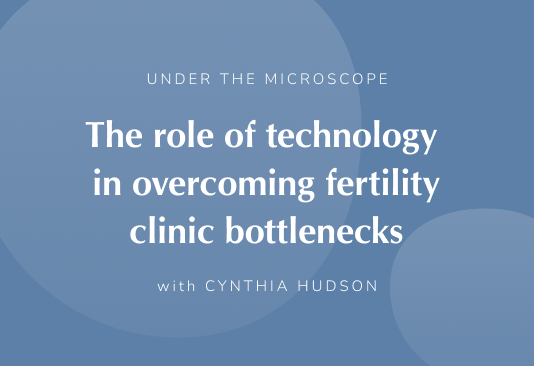



Cynthia Hudson has worked as an embryologist, medical technologist, and strategic advisor in some of the nation’s leading IVF practices for over two decades. In this edition of Under the Microscope, we explore her perspectives on how innovative technologies can solve clinic bottlenecks and expand access to much needed reproductive care.
One of the issues is the extreme cost of delivering fertility care, which is an endemic challenge to our industry. Historically, we’ve done things in a very manual way that is inefficient from a patient perspective. There are a lot of steps in the process of family building and bumps along the road, and it’s never really been a priority for the industry to knock down some of those barriers.
There’s a very large gap between the demand for care and access to care. If people providing the services perceive they have enough business, they don’t have a great incentive to further widen the top of the funnel. Recently there have been pressures on the fertility industry to expand their capacity because of initiatives that broaden access to care – in the form of mandates and 3rd party coverage for treatments. Expanding access to care has been a focus in my life and career, and I like to explore and use different ways of attacking that problem. LEVY Health is a way of opening the top of the funnel to allow more women to enter that space.
The current wait time is around six weeks for a new patient appointment at a clinic. When a patient shows up at the appointment, they get asked a series of questions and have a standard workup. Then that patient goes out and spends another four to six weeks answering some questions, getting tests, and scheduling another follow-up. Now we are two to three months into the process – it’s a very inefficient use of REI time, patient time, and clinic time. With LEVY Health, we can cut much of that out and go straight to treatment. We all know that a woman’s age is the most influential factor on someone’s chances of having a baby, so reducing the amount of time wasted is critical to their chances of success.
Another problem facing the industry is that there is a staffing shortage in certain regions. Fertility care is a very labor-intensive process, and the number of patients you can treat is directly related to the number of staff that you have. Reducing the number of required patient visits before treatment allows us to see and treat more patients. Increasing the capacity to treat more patients is a bigger problem than just staffing – we need bigger labs and more efficient processes and procedures. Introducing automation and standardization into fertility care is a big area of interest for me.
There are new technologies, tools, and devices that help to streamline certain aspects of the embryology laboratory workflow. For instance, a device that helps process sperm not only reduces the number of steps but also improves safety by removing opportunities for error. The time-lapse incubator is another example of technology that takes some of the manual steps out of the process to make the workflow more efficient.
I’m working with a company now called TMRW Life Sciences that has built a specimen management system for frozen tissues in the IVF laboratory. There is mechanical automation that stores and retrieves the specimens for you. There is software automation for decision-making and data entry involved in that workflow. So instead of me as a human deciding where this embryo is going to be placed until the patient wants it back, the software decides, checks it in and out of the storage location using RFID, and automatically updates the clinic’s Electronic Health Record System. So that data only needs to be entered once and the inventory gets updated in real-time.
We have opportunities for automation on both sides (hardware and software) to remove some elements of the process that don’t require the skillsets of humans and embryologists.
Absolutely. It’s not possible to scale our industry in its current form. There’s no way to safely and sustainably scale these kinds of human-led processes and address the unmet need that is just staring us in the face. We have to figure out a way to utilize our resources wisely to optimize the time spent.
If we introduce technology and a way to shortcut the steps to get from A to B, we can process infinitely more samples. I think that right now, as an industry, we’re vastly underutilizing the available technology. A stumbling block for some is the resistance to change and upending their current organization chart or workflow. So in a way, it’s sometimes easier to start a new facility or clinic and start with those fundamentals.
Take, for instance, integrating a new scheduling app for our patients. Patients wouldn’t have to call someone to make an appointment and the clinic wouldn’t have to pay someone to sit there and answer the phone.
However, introducing that to an existing infrastructure can disrupt an organizational chart and might make a few employees redundant, which can be a difficult discussion for some clinics. Plus, there’s always a learning curve for adapting new systems. Then you either have to integrate that scheduling app with the clinic’s Electronic Health Record (EHR) system or change your EHR to one that has one already. So there are barriers in the form of time, cost, and willingness to change. I would argue that the reason most clinics don’t change is that it’s just too disruptive and is perceived as too costly.
If you have a very busy clinic, and you’ve always done things a certain way, you’ve made enough money and you’re very happy with your margin, you’re less likely to adopt that change. The technology is available, but you need the will to adopt it.
One clinic I’m advising isn’t well-staffed on the laboratory side and is resisting the adoption of an electronic witnessing system. My key argument to them is that they could get away with some reduced staff IF they had an electronic witnessing system – because if there is only one person in the lab, there is no one needed to witness the step.
There’s resistance to change because “that’s the way they’ve always done it”. Not to mention it’s going to cost them money to make a change and adopt this new system. However, the cost of being properly staffed far outweighs the cost of adopting this technology. So we’re left in a position where it seems patently obvious to some and not to others that this is the best next step for their organization.
LEVY Health is a great example of that, which is why I’m such a big fan of the team and the technology. Reproductive endocrinologists always ask the same questions in the first appointment with the patient. If they answer one way, they’re asked this question next, and if they answer another way, they’re asked another question. It follows a basic pattern because every single person coming to the clinic wants to have a baby.
But with LEVY Health, by the time we see the patient the first time, they’ve already answered every question we were going to ask and have been properly assessed using the tests we would have ordered. We now can utilize that time with the patient on that first visit and get them right into treatment.
Thanks to LEVY Health’s technology, we wildly free up REI time because now when we see patients, we can get to the heart of the matter. If we find that there’s something else that we would like to investigate more, we’re certainly free to do so. But we haven’t wasted three months of the patients’ time and two hours of consultation, during which we’re not getting the patients any closer to their goal. LEVY Health’s clinical decision support software allows us to shortcut that process.
This goes back to the staffing costs. Having staff at the front desk, plus the nurse, and the physicians – when we are asking all these patients the same questions over and over again – carries significant overhead. But why in the world would we utilize that precious resource of staff and time when we could be treating more patients? For me, it’s a no-brainer.

When you’re struggling with fertility, one of the first places to look is your hormones. Certain vital reproductive hormones are in charge...

When you test your fertility with LEVY, you will always check your basic reproductive hormone levels (including FSH, LH, TSH, Prolactin, Estradiol,...

Not getting your period is a condition called amenorrhea. It’s important for fertility because not having a menstrual cycle with monthly ovulation...

How you nourish your body is key not only when you have a baby in your belly, but also to help prepare...

Why IVF fail: Although in-vitro fertilization (IVF) can help many people who weren’t able to conceive naturally have a child, there’s unfortunately...

Getting your daily recommended amount of vitamins and minerals is key to getting pregnant and having a healthy pregnancy. So, how does...

FSH, LH, estrogen, progesterone… If you’re struggling to have a baby, you’re probably becoming an expert on all things hormones. AMH is...

Women have two ovaries which are located on either side of the uterus. They’re around 3-5 cm long – about the size...

If you’ve been trying to conceive for a while, it’s totally normal to feel frustrated. Why hasn’t it happened for you yet,...
Ja, ich möchte mich kostenfrei für den LEVY Fertility Code anmelden und den LEVY Newsletter abonnieren. Ich erhalte auf mich abgestimmte Informationen und weitere Details zum LEVY Fertility Code an die angegebene E-Mail-Adresse.
